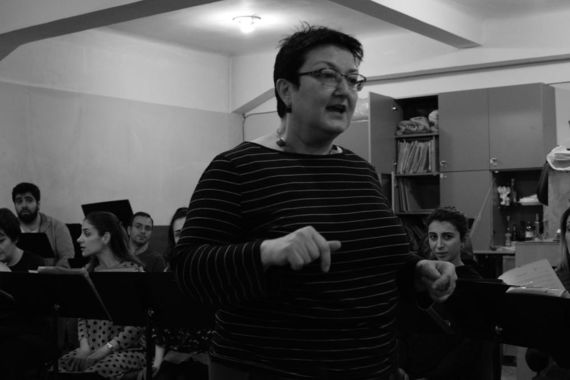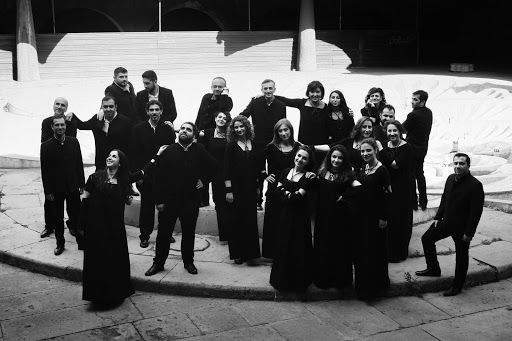
Sona Hovhannisyan during rehearsal.
Image by Gevorg Mnatsakanyan.
Sona Hovhannisyan doesn’t believe her life story to be of much interest to others. Honestly. In fact, she’s certain of it. Though she might be wrong. But no, she’s certain of it.
It takes the Artistic Director of the Hover State Chamber Choir and now first woman Rector of the Yerevan State Conservatory a few seconds to sum up the story of her life into one of music and motherhood and a few seconds more to regrettably admit that neither have followed convention (whatever that means).
Disappointment with herself, bordering on self-deprecation is a recurrent theme in Hovhannisyan’s life and there seem to be many causes for it. Not that anyone close to her agrees with her.
Hesitant at first, she quickly admits that the first of such disappointments lies with her disinclination for “traditional” parenthood, one made all the more potent in the face of her own positive experience of it as a child.
“I was born into beauty,” Hovhannisyan says about her mother with a smile that leaves one wanting to know more about who she was, what she looked like and her role in Hovhannisyan’s life. But Hovhannisyan is far too reserved a character to go into such details. She references her mother only to reflect on her own failure to mature into a traditional mother, which she defines as one who dedicates herself completely to her child. “I didn’t do so with my son despite his need of it,” says Hovhannisyan. “That life was simply not meant for me.”
She blames her lack of self-discipline for this and many more of her perceived shortcomings. And while she concedes that her failures as a mother stemmed from nothing less than her desire to experience life to its fullest, for her “deep love” of it, her son, Minas Asryan, couldn’t disagree more with her.
“Frankly speaking, I don’t know what mum means by ‘traditional,’ but I know that I never felt abandoned,” Minas says. “Sure, she often left me to my choices and held me responsible for them, but she was always by my side. If anything, I was always amazed by her ability to so skillfully manage the choir, while also taking care of me.”
Hovhannisyan’s frustration with herself in personal matters is, well, a strictly personal matter. But in the frenzy of the Karabakh Movement that swept across Soviet Armenia and the small Armenian enclave in neighboring Azerbaijan in 1988, her nascent political discontent was shared with millions of Armenians increasingly disillusioned with the failing Soviet system. And although independence, declared in 1991, brought hope for a brighter future, the Movement soon failed to justify itself and even devout supporters like Hovhannisyan were quickly disillusioned.
“Maybe this is why I’m so at ease with the current revolution,” says Hovhannisyan about the civic disobedience movement of 2018 that toppled the government of former President Serzh Sargsyan, despite admitting to her failure to take active part in it. “It’s not that I was skeptical of the uprising, but I couldn’t bring myself to get involved personally.” Reclining in her office chair as she says this, one can see that past experiences of political vocalism have clearly taken their toll on her.
“Not that much has changed in my life since the revolution,” Hovhannisyan says casually with a smile, defying the reality of her recent appointment under the country’s new leadership.
She explains that she had already been carrying out her own small revolutions long before the Velvet Revolution in the form of reimagined concert practices that reintroduced forgotten masterpieces of Armenia’s rich musical heritage, while doing away with those Soviet concert traditions that never satisfied her. In her newfound position as Rector, Hovhannisyan intends to extend her innovative attitude to the Conservatory so that, in her words, “We don’t have to experience the cataclysmic effects of large revolutions in the future.”
One such (not so small) revolution came in 1992 with the founding of the Hover choir that soared as a beacon of hope for a growing body of musicians largely depressed by Armenia’s crumbling music scene. “Hover not only allowed to preserve the art of choral music in Armenia,” says Yeva Podpomogova, the longest-standing member of the choir, “but also provided a bright corner where you could break away, even if only for a few hours, from your daily routine and the troubles that came with it in the early years of independence.”

Hover State Chamber Choir.
Image by Mane Hovhannisyan from the Hover Choir official website.
Not that Hovhannisyan paid much heed to these troubles, being so completely immersed in her own work. It comes as no surprise then that she sees little of the revolutionary in the founding of the choir when she can’t even pinpoint her reasons for establishing it in the first place. But in talking about Hover’s performance of “technically and ideologically complex pieces” during the equally “difficult times” of early independence, Hovhannisyan makes it clear that the choir was nothing more than the point of convergence of musical friends wanting to be together in music.
The name “Hover,” Armenian for zephyr, was chosen in reference to the great Armenian musicologist and composer Komitas’ frequent use of the word in his chorales. But beyond Komitas, Hovhannisyan was taken by the element of the untamed, the impalpable and, most of all, plurality conveyed by the term.
“I wanted everyone in the choir to feel unique in this plurality,” Hovhannisyan said.
Since its inception and no shortage of performances on world stages spanning Teatro Dal Verme to Cité de la Musique and Carnegie Hall (to name but a few), much has changed about the ensemble. Beyond its nationalization in 2009, which introduced the choir to state organized concerts and a fixed state stipend, and the changed composition of the choir over the years, the most radical transformations are those that have occurred among the singers.
“We have reached a point in our relationship where we don’t necessarily have to speak to understand one another,” Hovhannisyan says. “And once you reach this point, the next big question is always: what’s next?”
Arthur Manukyan, a tenor with the choir since 1997, seems to believe that it doesn’t matter. “The beauty of Hover is that it isn’t concerned with where it’s going,” he says. “We formulate ephemeral goals to fool ourselves into believing that we’re actually pursuing something concrete, but the truth is the choir is a living organism that simply strives to move forward. So Hover is timeless – it belongs neither to the past, present, nor future. Though none of it would be possible without Sona’s exceptional leadership.”
Complementing Manukyan in word as in song, Hovhannisyan explains that “even the most beautiful thing – if it doesn’t go through change – becomes rigid and loses its relation to art. And although I don’t believe that the choir has become rigid, too much has changed about it, and about me, to still be able to talk about it as Hover.”
But what then? “Lé!” Hovhannisyan exclaims as she almost leaps out of her chair, radiating excitement. The two-letter expression is unique to Armenia, used in its traditional songs both as an exclamation and to denote a young girl, which is what attracted her to it in the first place.
“I love ‘Lé.’ It’s short and to the point,” Hovhannisyan said.
Despite her fascination with the female component of “Lé,” Hovhannisyan is quick to brush off its significance in the context of her appointment as the first female rector of the Conservatory. Instead, she talks of “images” of the future Conservatory, which she wishes to see become reality. With her chin resting on her hand, she paints a beautiful picture of a small garden with incense trees and stepping stones replacing the cement pavement in front of the conservatory; of music escaping the conservatory’s open windows for everyone’s enjoyment and most importantly of an improved study environment for its students.
“This is what it means for me to be a Rector,” said Hovhannisyan with a timid smile.



